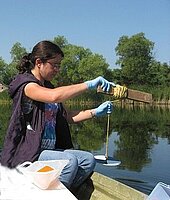Temporal-spatial distribution (dynamics) of phytoplankton and diversity in relation to lake physical and chemical condition

Veselina Valkov is a PhD student in Environmental Conservation Science program at North Dakota State University. She holds a Master of Science degree in Ecology and Environment Protection from Technical University, Varna, Bulgaria. Her research Master thesis focused of understanding the Biochemical-genetic Analysis of the Black Sea Population Trachurus Mediterranean Ponticus. She worked for Institute of Oceanology - Bulgarian Academy of Science, Marine Biology and Ecology Department. As research biologist she Studied phytoplankton microscopic samples taken during the seasonal monitoring of the biological conditions in the Black Sea shelf and worked on projects for preservation and ecological conditions of the Black Sea. Monitored and recorded the populations of alien and invasive species to the Black Sea, study of phytoplankton identification, blooms and seasonal cycles. Later as Inspector Ministry of Environment and Water Resources of Bulgaria In Regional Inspection of Environment and Water Resources – Varna she executes control and performs analysis of the waste water generated by businesses and other entities to assure compliance with the provisions of the Environmental Protection Act.
Email: veselina.valkov@ndsu.edu
Phone: 701-231-7051
Fellow: Veselina A. Valkov
Advisor: Dr. Wei Lin, Associate Professor, Department of Civil Engineering North Dakota State University
Degree Progress: PhD in Environmental Conservation Science
Temporal-spatial distribution (dynamics) of phytoplankton and diversity in relation to lake physical and chemical condition
Eutrofication as a result of anthropogenic input of nutrients especially phosphorus and nitrogen, that cause real (or perceived) concerns for surface water quality, is significant problem for North Dakota lakes and reservoirs. Biological productivity is high and the diversity of biological populations may be limited. The increased input of nutrients causes excessive and rapid growth of phytoplankton and massive blooms. Such a blooms cause reduces light penetration and nutrient availability to other algal species, lower algal diversity, increase turbidity and forms floating films (especially Cyanophiceae). Sedimentation of dead algae biomass results in increase of organic matter in the sediments and decomposition of organic sediments cause oxygen depletion and forming anoxic condition at the sediment surface. the deep water fauna becomes deprived of oxygen. Anoxic condition causes change in microbial and chemical processes. The release of nutrients from the anoxic sediments (internal loading) especially phosphorus causes self acceleration of eutrophycation. Spectacular fish kill may result from advanced eutrophycation.
Phytoplankton are defined as freefloating unicellular, filamentous and colonial organisms that grow photo-autotrophically in aquatic environments. They are the basis of food chainsweb and directly provide food for zooplankton, fishes and some aquatic animals. Phytoplankton has a short vegetation season thus it responds quickly to changes in water physical and chemical characteristics. That affects phytoplankton spatial-temporal composition and production, as well as the ecosystem structure and function. Phytoplankton abundance and diversity are widely used as biological indicators of still-water quality in lakes.
The main concerns related to eutrophication appear when lake fails to meet its intended use for water supply, fisheries, and recreation or with impaired aesthetic qualities. Algal blooms fueled by eutrophication may cause significant water quality changes are expressions of decreased diversity in the phytoplankton communities, dominant growth of certain species but also affect other pelagic and benthic communities.
The researches on correlation between temporal-spatial distribution and diversity, and physical and chemical are not very well developed in details.
This research will address the impacts of changing physical and chemical condition on phytoplankton growth, spatial distribution and diversity in a eutrophic lake. Field samples will be collected to identify how change in nutrient concentration especially N and P ratios impact the seasonality of phytoplankton. Physical, chemical and biological data will be analyzed to explore how phytoplankton growth will change water quality, such as DO, turbidity, light penetration and chemical composition that in turn may affect phytoplankton ecology. Heinrich –Martin impoundment is in La Moure county in North Dakota is selected the research site, because is accessibility size and data from previous research.
Project Objectives:
To expand existing research on water quality of the eutrophic impoundment Henrich Martin Dam and to understand how variation in physical and chemical disturbances influenced spatial - temporal phytoplankton distribution and diversity and can cause shifts in changes in community patterns.
The scientific questions that need to be addressed with regard to eutrophication condition including:
- the qualitative characters of the ecosystem responses ("what changes?"),
- their amplitudes ("by how much?"), and
- their timing and spatial and temporal scales ("when and where are rates of change most profound?").
To analyze the distribution and diversity of phytoplankton during the seasons to identify the cause(s) algae patterns relative to the physic and chemical condition. How the phytoplankton growth will affect the water physical and chemical condition.
The abundance of dominant species should be examined and connected to the physic and chemical condition. How these dominant species will affect water physical and chemical condition.
To understand physical and chemical processes, such as oxygen balance and nutrient release, in water column that are important to phytoplankton growth and entire lake ecological function.
Analyze environmental factors to assess long term impact of water quality. For example, test effectiveness of aeration on biodiversity and water quality.
Progress:
Based on the understanding of the site from previous research, 5 sampling locations were selected and preliminary sampling started on June 4th, 2010.
In the study period the temperature increased from June, 6 until July, 7 (maximum of 26.58°C), in addition duration of the day and nutrient supply, the entry of given taxon into the succession sequence is indicated quantitatively. During the July and August study period, ten classes were identified: Bacillariophyceae, Dinohyceae, Chlorophyceae, Chryptophyceae, Chrysophyceae, Cyanophyceae, Euglenophyceae, Synurophyeceae and Zygnematophyceae. At the beginning of the sampling period in June Bacillariophyceae was dominant class in terms of species numbers, density and biomass and in the beginning of July is replaced from the Dinophyceae. Class Chrysophyceae was found once in June 18 probably due to their requirements for high water temperature or nutrition supply. The transitional period between these two dominant classes is characterized with more diversity when all classes are presented.
DO generally is decreasing with increasing the temperature in temporal scale. Concentration varied between 9.50 and 7.50 mg/l in the surface layers and in the bottom DO vary between 1.00 and 4.00 mg/l in all station in June. DO variations could be correlated with high algal abundance on the surface diurnal variation phytoplankton growth, as a function of sunlight, respiration and photosynthesis and microbiological activity.
The highest Secchi depth of 2.5 m. in all station was found Chla and turbidity was low concentrations. Strong wind , ntensive mixing of the surface layers, increased TSS and turbidity were favorable for class Bacillariophyceae as most abundant genus - Asteroinella sp., Fragillaria sp. and Aulacoseira sp. reaching concentration 5.55 x 106 cells/l and 9.18 x 10 4 cells/l respectively. These taxa were abundant also at time when the soluble reactive phosphorus (SRP) and total phosphorus (TP) were relatively low. The Asteroinella sp. disappeared in July, while Fragillaria sp. and Aulocosera sp. remained in the water column with some disparity among the sites. Variation among the Dinophiceae species also was found. Variation of species needs to include factors as temperature, light and nutrient requirements, and competition among the phytoplankton.
Chla spatial concentrations varied depending on the wind direction and depth of the sites. The high concentration of phytoplankton occurs on the Secchi depth, instead of the surface likely because of the effect of the aeration system which was operated in the summer months o increase bottom layer DO in the lake. At less affected sites the highest values of Chla were detected in the surface layer. After rapid growth of phytoplankton on July, 23 these concentrations remained high until 17 of September, when a decrease started along with ambient temperature decrease.
NO2-N varied between 0.00 and 2.26µg/l. The highest concentration 2.26µg/l was measured on 6, June when the highest Chla concentration was 73.51 mg/l. No significant change was found with the depth. NO3-N was ranged between 0 and 0.1733 mg/l. The highest concentration of was detected on 7/23/2010 on 2.5 m. where the Chla was also high concentration 60 944 cell/l.
NH4-N remains low during the all sampling events. The relatively high values detected in depth are likely because of rapid growth of phytoplankton, high temperatures and low DO.
As a typical controlling algal growth factor SRP varies in concentration fallowing the temporal variation in temperature. SRP only slightly changes in depth, because of the wind and aeration system impact. No clear correlation was found between the phytoplankton growth and SRP. This is indirect assumption that some SRP is not available for utilization by phytoplankton, and that the actual useable resource level for them is somewhat lower than the measured SRP. TP increases with the same trend and after the SRP peak remains stable for an additional month and then decreases. SRP as well as other nutrient concentrations were no limitation factors for phytoplankton growth. Based on these preliminary results I will continue to develop knowledge and my research, moving forward answering questions emerged and solve the relationships. Moving forward I fill myself motivated as a researcher.
Significance:
Changes in the diversity of phytoplankton algae species and their relative numbers can be used to gauge water quality changes.
Apply knowledge on variation of phytoplankton population distribution and diversity can contribute to better understanding of ecological status of eutrophic lakes and future changes to the other water bodies.
The spatial-temporal distribution and diversity according to the physical chemical condition – seasonal mean and maximum abundance together with Chla concentration can be used to determine impairments, and many monitoring programs.
The knowledge about the correlation between fresh water phytoplankton and physical and chemical factors could be use for controlling of problematic excessive algae growth, especially for nuisance species.
The phytoplankton play a key role in global climate change by removing carbon from the atmosphere and injecting it into the water bodies, also they are involved into nutrients cycle through environment.
Conference:
Veselina Valkov Poster Young Professionals 2010 Poster Competition at the NDWPCC "Temporal-spatial distribution (dynamics) of phytoplankton and diversity in relation to physical and chemical condition". 13 Oct 2010, Fargo, ND.

Wei Lin
Civil & Environmental Eng.
Office: Civil/Ind Eng 201D
Telephone: 701-231-6288
Email: wei.lin@ndsu.edu


